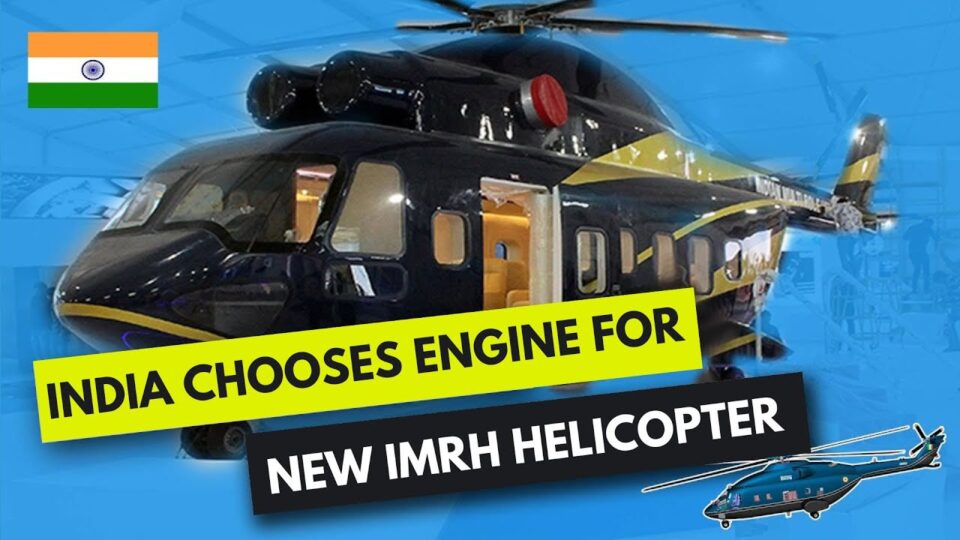Aviation
India Launches Its Medium-Lift Class Helicopter Program, chooses New Engine

India’s longstanding need for a Medium Helicopter may soon become a reality as the country has fully ramped up its engine development efforts. This new helicopter is set to replace the Russian-built models currently in service and will play a crucial role across various scenarios for the Indian Armed Forces.
Hindustan Aeronautics Limited (HAL) and SAFHAL Helicopter Engines Pvt. Ltd. (SAFHAL) have launched a groundbreaking partnership to develop a state-of-the-art high-power engine named Aravalli.
This new engine will power the upcoming 13-ton Medium Lift Helicopter (IMRH) and the Deck-Based Multi-Role Helicopter (DBMRH), both of which are being designed and developed by HAL.
Named after the majestic Aravalli mountain range in India, the Aravalli engine symbolizes the country’s drive for self-reliance, or Aatmanirbharta, in critical engine technologies. This cutting-edge engine will be instrumental for the IMRH, a versatile 13-ton multi-role helicopter designed to meet the needs of the Indian armed forces, and the DBMRH, a 12.5-ton naval variant tailored for the Indian Navy.
The IMRH is poised to become a cornerstone of the Indian armed forces over the next decade. With its first flight expected in 3 to 4 years, the IMRH is anticipated to begin induction by 2030, with plans to integrate between 300 to 400 units, and potentially more in the future.
The IMRH is envisioned as a highly versatile multi-role helicopter that will enhance the operational capabilities of the Indian military. The DBMRH, designed for naval operations, will also face the challenges of high-altitude environments in regions such as Ladakh, Sikkim, and Arunachal Pradesh—areas of strategic importance due to their proximity to the China border.
In addition to its military applications, the Aravalli engine is projected to enter the civil market, serving roles in offshore operations, utility services, and VVIP transport. The long-term vision includes Maintenance, Repair, and Overhaul (MRO) activities to further extend the engine’s utility and support the aviation industry.
This collaboration between HAL and SAFHAL builds on their successful history of working together on the Shakti engine, which powers several HAL helicopters, including the Advanced Light Helicopter Dhruv, the Light Combat Helicopter Prachand, and the Light Utility Helicopter. The proven success of this partnership lays a strong foundation for the development of the Aravalli engine, setting the stage for a new era in India’s helicopter capabilities.

Aviation
China Eastern Receives Its Ninth C919 Aircraft, Marking a New Milestone

China Eastern Airlines (CEA) has reached a significant milestone with the delivery of its ninth COMAC C919 aircraft, continuing its lead as the launch customer for China’s domestic narrow-body airliner.
On Thursday, the airline received the latest addition to its fleet, registered as B-657T, marking another step in China’s ambitious efforts to establish itself as a key player in the global aerospace market.
Virgin Australia Launches Black Friday Sale on Flights Worldwide
This delivery is part of a major achievement for COMAC (Commercial Aircraft Corporation of China), which has now delivered a total of 10 comac c919 in 2024 alone, a remarkable increase from just three jets delivered by the end of 2023.
The C919 program represents China’s entry into the competitive market for commercial aircraft, aiming to rival the dominance of manufacturers like Airbus and Boeing in the narrow-body sector.
These 6 Airlines Are Giving You Free Wi-Fi on Your 2025 Flights
One standout feature of the c919 is its innovative in-flight technology, particularly its Wi-Fi system. Developed by the China Electronics Technology Group Corporation (CETC), this system allows passengers to connect to the “CEAIR-WIFI” wireless hotspot, providing seamless access to in-flight entertainment.
Through the website www.muflyer.com, travelers can enjoy a range of features including “Air Cinema” and “Air Games,” which enhance the flying experience.
Looking ahead, COMAC’s ambitions are not limited to narrow-body aircraft. At the 15th China International Aviation and Aerospace Exhibition in Zhuhai, c919 aircraft price made waves with the announcement of over 100 new aircraft orders.
A significant highlight was a high-profile agreement with Air China for the development of the C929, a widebody aircraft set to compete c919 vs a320 and c919 vs 737 with these models.
-

 Aviation2 months ago
Aviation2 months agoMicrosoft Flight Simulator Raises $3 Million to Bring Back the An-225 Mriya
-

 Airlines2 months ago
Airlines2 months agoQatar Citizens Can Travel to the United States Without a Visa
-

 Aviation2 months ago
Aviation2 months agoQatar Airways bans these new Electronic Devices on plane
-

 Defence2 months ago
Defence2 months agoWhich Country Has the Largest Fleet of Fighter Aircraft?
-

 Airlines1 week ago
Airlines1 week agoDAMAC Air: Dubai’s New Luxury Airline Offers Free Flights for Registration
-

 Airport2 months ago
Airport2 months agoWestern Sydney Airport Welcomes Its First Plane After 6 Years of construction
-

 Airlines6 days ago
Airlines6 days agoAir India to Launch aircraft maintenance training institute in Bengaluru
-

 Aviation2 months ago
Aviation2 months agoDid you know ? Once Boeing 747 carried 1088 passenger in 1991








